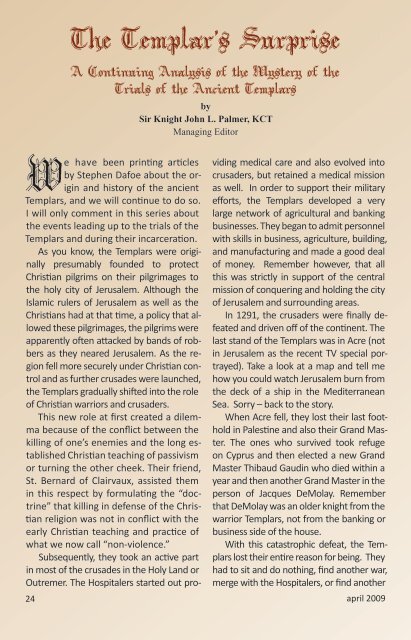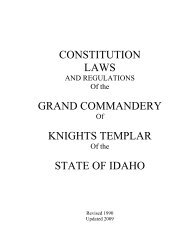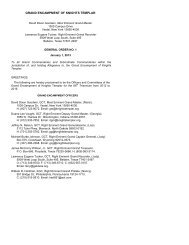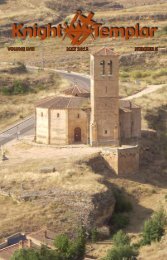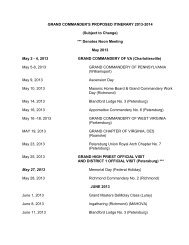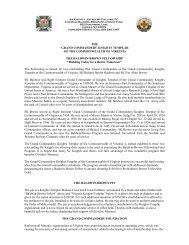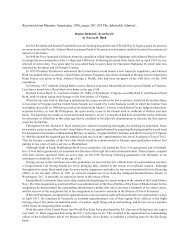APR - Grand Encampment, Knights Templar
APR - Grand Encampment, Knights Templar
APR - Grand Encampment, Knights Templar
Create successful ePaper yourself
Turn your PDF publications into a flip-book with our unique Google optimized e-Paper software.
The <strong>Templar</strong>’s Surprise<br />
A Continuing Analysis of the Mystery of the<br />
Trials of the Ancient <strong>Templar</strong>s<br />
by<br />
Sir Knight John L. Palmer, KCT<br />
Managing Editor<br />
We have been printing articles<br />
by Stephen Dafoe about the origin<br />
and history of the ancient<br />
<strong>Templar</strong>s, and we will continue to do so.<br />
I will only comment in this series about<br />
the events leading up to the trials of the<br />
<strong>Templar</strong>s and during their incarceration.<br />
As you know, the <strong>Templar</strong>s were originally<br />
presumably founded to protect<br />
Christian pilgrims on their pilgrimages to<br />
the holy city of Jerusalem. Although the<br />
Islamic rulers of Jerusalem as well as the<br />
Christians had at that time, a policy that allowed<br />
these pilgrimages, the pilgrims were<br />
apparently often attacked by bands of robbers<br />
as they neared Jerusalem. As the region<br />
fell more securely under Christian control<br />
and as further crusades were launched,<br />
the <strong>Templar</strong>s gradually shifted into the role<br />
of Christian warriors and crusaders.<br />
This new role at first created a dilemma<br />
because of the conflict between the<br />
killing of one’s enemies and the long established<br />
Christian teaching of passivism<br />
or turning the other cheek. Their friend,<br />
St. Bernard of Clairvaux, assisted them<br />
in this respect by formulating the “doctrine”<br />
that killing in defense of the Christian<br />
religion was not in conflict with the<br />
early Christian teaching and practice of<br />
what we now call “non-violence.”<br />
Subsequently, they took an active part<br />
in most of the crusades in the Holy Land or<br />
Outremer. The Hospitalers started out providing<br />
medical care and also evolved into<br />
crusaders, but retained a medical mission<br />
as well. In order to support their military<br />
efforts, the <strong>Templar</strong>s developed a very<br />
large network of agricultural and banking<br />
businesses. They began to admit personnel<br />
with skills in business, agriculture, building,<br />
and manufacturing and made a good deal<br />
of money. Remember however, that all<br />
this was strictly in support of the central<br />
mission of conquering and holding the city<br />
of Jerusalem and surrounding areas.<br />
In 1291, the crusaders were finally defeated<br />
and driven off of the continent. The<br />
last stand of the <strong>Templar</strong>s was in Acre (not<br />
in Jerusalem as the recent TV special portrayed).<br />
Take a look at a map and tell me<br />
how you could watch Jerusalem burn from<br />
the deck of a ship in the Mediterranean<br />
Sea. Sorry – back to the story.<br />
When Acre fell, they lost their last foothold<br />
in Palestine and also their <strong>Grand</strong> Master.<br />
The ones who survived took refuge<br />
on Cyprus and then elected a new <strong>Grand</strong><br />
Master Thibaud Gaudin who died within a<br />
year and then another <strong>Grand</strong> Master in the<br />
person of Jacques DeMolay. Remember<br />
that DeMolay was an older knight from the<br />
warrior <strong>Templar</strong>s, not from the banking or<br />
business side of the house.<br />
With this catastrophic defeat, the <strong>Templar</strong>s<br />
lost their entire reason for being. They<br />
had to sit and do nothing, find another war,<br />
merge with the Hospitalers, or find another<br />
24 april 2009


